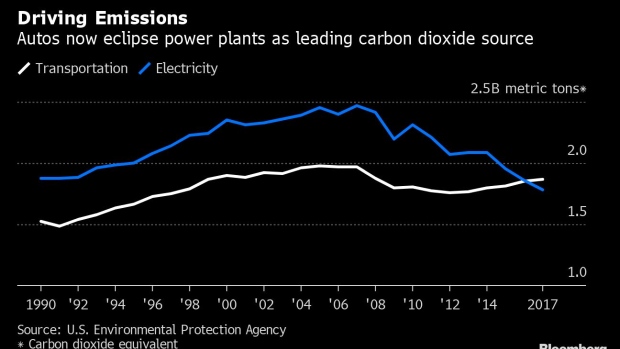Sep 19, 2019
Climate Scientists Alarmed by Trump’s Move to Undercut Auto Emission Rules
, Bloomberg News

(Bloomberg) -- In the fight against climate change, gas-guzzling cars are increasingly seen as the biggest enemy.
Carbon dioxide from automobiles has surged in the U.S. at the same time that the emissions have declined from power plants. The transportation sector is now the nation’s single biggest source of greenhouse gas emissions -- beyond electrical generation from coal, leaking oil wells and burping cows.
That’s why environmentalists and climate scientists are alarmed by the Trump administration’s move this week to undercut the regulation of auto emissions.
“You can’t solve the climate change problem without cleaning up the cars,” said David Doniger, senior strategic director for the Natural Resources Defense Council’s climate program.
The Trump administration took the first step Thursday, by revoking California’s authority to set auto emissions requirements that are stricter than what the federal government requires. The administration is still working to finalize the second step -- a plan for weakening existing federal fuel-economy and tailpipe emissions standards on track to for later this year.
Greenhouse gas emissions from vehicles were already on the rise before Trump took aim at the standards, climbing as American motorists drive more and new-car buyers abandon traditional sedans for less-efficient, bigger vehicles. Light-duty vehicles and large heavy trucks are responsible for 82% of the greenhouse gases from transportation, with releases from commercial aircraft, ships and trains contribute another 14%, according to EPA data.
The transportation sector eclipsed power plants as the largest single U.S. source of greenhouse gas emissions in 2017, as utilities shifted away from coal to embrace cleaner-burning natural gas and renewable sources of electricity. That downward trend has continued, even though the Trump administration repealed President Barack Obama’s Clean Power Plan throttling greenhouse gas emissions from the electric sector.
Why Trump Attacks California’s Anti-Pollution Powers: QuickTake
Federal vehicle standards were expected to help pare auto emissions. Instead, the Trump administration’s proposal to freeze auto standards at 2020 levels -- rather than requiring steady annual improvement toward a roughly 50 mile-per-gallon goal -- would unleash them. According to an analysis by the economic research firm Rhodium Group, the administration’s proposal would lead to as much as 931 million metric tons more carbon dioxide between 2022 and 2035.
Environmental Protection Agency Administrator Andrew Wheeler has signaled the final rule will require small annual improvements, though still at levels far less than required under the current standards.
The Trump administration disputes the potential climate impact, estimating in an analysis last year that its auto plan would only boost atmospheric carbon dioxide concentrations by 0.65 parts per million by 2100. Wheeler on Thursday asserted that the changes “will have a negligible impact on the environment.”
EPA Slams California’s Air Quality as It Curbs State’s Authority
Wheeler pointed to an Obama-era analysis of a much tougher approach than the one that the government ultimately adopted, arguing that even that “would have only lowered global temperatures by two-one hundredths of a degree Celsius by 2100.”
But environmentalists argue that’s a cynical look at the magnitude of the climate problem -- and how individual emitters add up globally.
“This is such a vast problem that is the result of so many sources, that if you pick any single one of them, you could say” it is not significant, said Janet McCabe, a former acting assistant administrator for air quality at the EPA. “But within that universe of things that the United States could do with one policy that would make as much of a difference as possible, the Clean Power Plan and the clean car rules were the most meaningful things the EPA could do.”
California Vows Fight as Trump Takes Aim at Clean-Car Authority
Rhodium found that freezing vehicle standards at 2020 levels would have a larger impact on U.S. greenhouse gas emissions than the Clean Power Plan repeal or the Trump administration’s separate effort to roll back limits on methane leaks from oil wells. The extra emissions would exceed what is released annually by 82% of countries today and be greater than the total generated by the world’s 70 smallest countries, Rhodium found.
Requirements also were expected to get tougher over time.
The initial standards were “just supposed to be a start,” Doniger said. “California is already looking at what should be the emission standards for post 2025. If the administration were doing their job, we would see them working on standards to get closer to the goal of zero emissions by tightening the standards for the internal combustion engine and continuing the electrification of the vehicle fleet.”
Automakers are making broad improvements to vehicle efficiency, with major companies announcing ambitious plans to field dozens of new, electric models in coming years. The impact of President Donald Trump’s auto plan also is magnified because the standards were designed to nurture a marketplace shift toward electric vehicles.
The move also undercuts the ability of states to fulfill their vows to aggressively attack climate change even in the absence of federal action -- pledges that were made after Trump said the U.S. would abandon a global accord to slash greenhouse gas emissions.
“Transportation is the nation’s largest source of climate pollution, and the administration is not only failing to confront that reality head-on, it’s attacking the rights of states who are defending the nation’s interest against the ever-worsening climate crisis,” said David Hayes, a former Interior Department deputy secretary who now leads the State Energy & Environmental Impact Center at NYU School of Law.
--With assistance from Ryan Beene.
To contact the reporter on this story: Jennifer A. Dlouhy in Washington at jdlouhy1@bloomberg.net
To contact the editors responsible for this story: Jon Morgan at jmorgan97@bloomberg.net, Elizabeth Wasserman
©2019 Bloomberg L.P.


